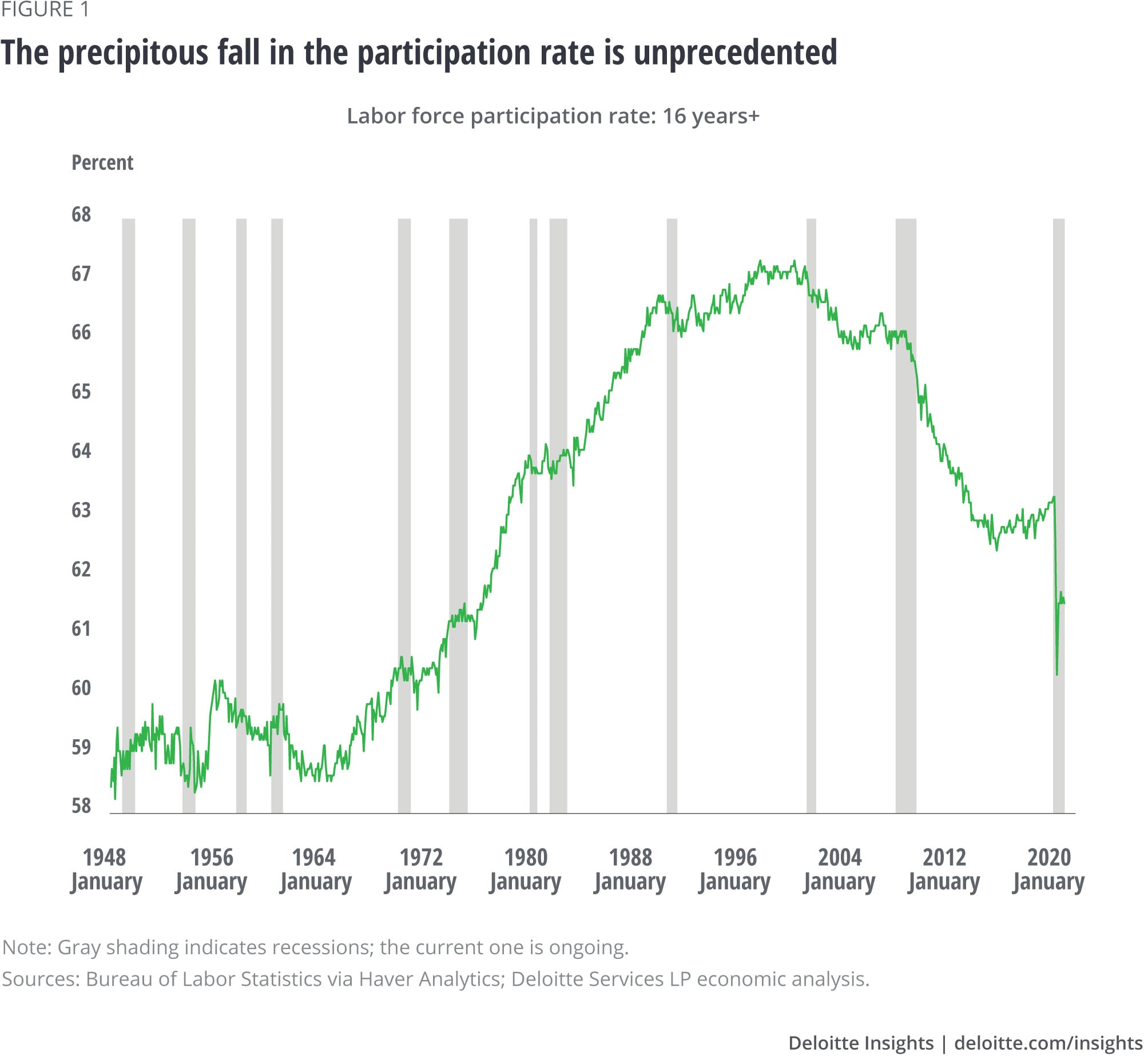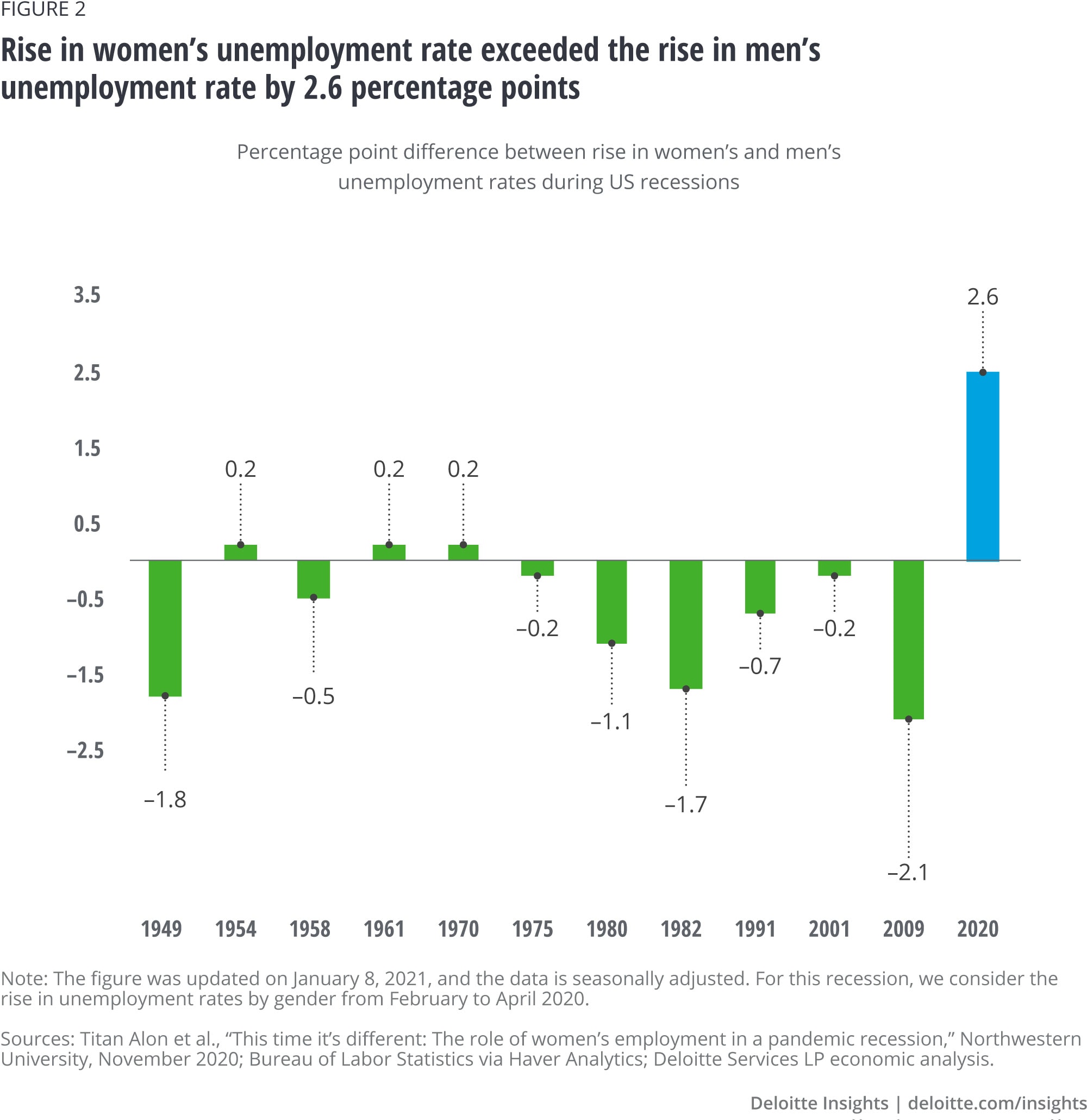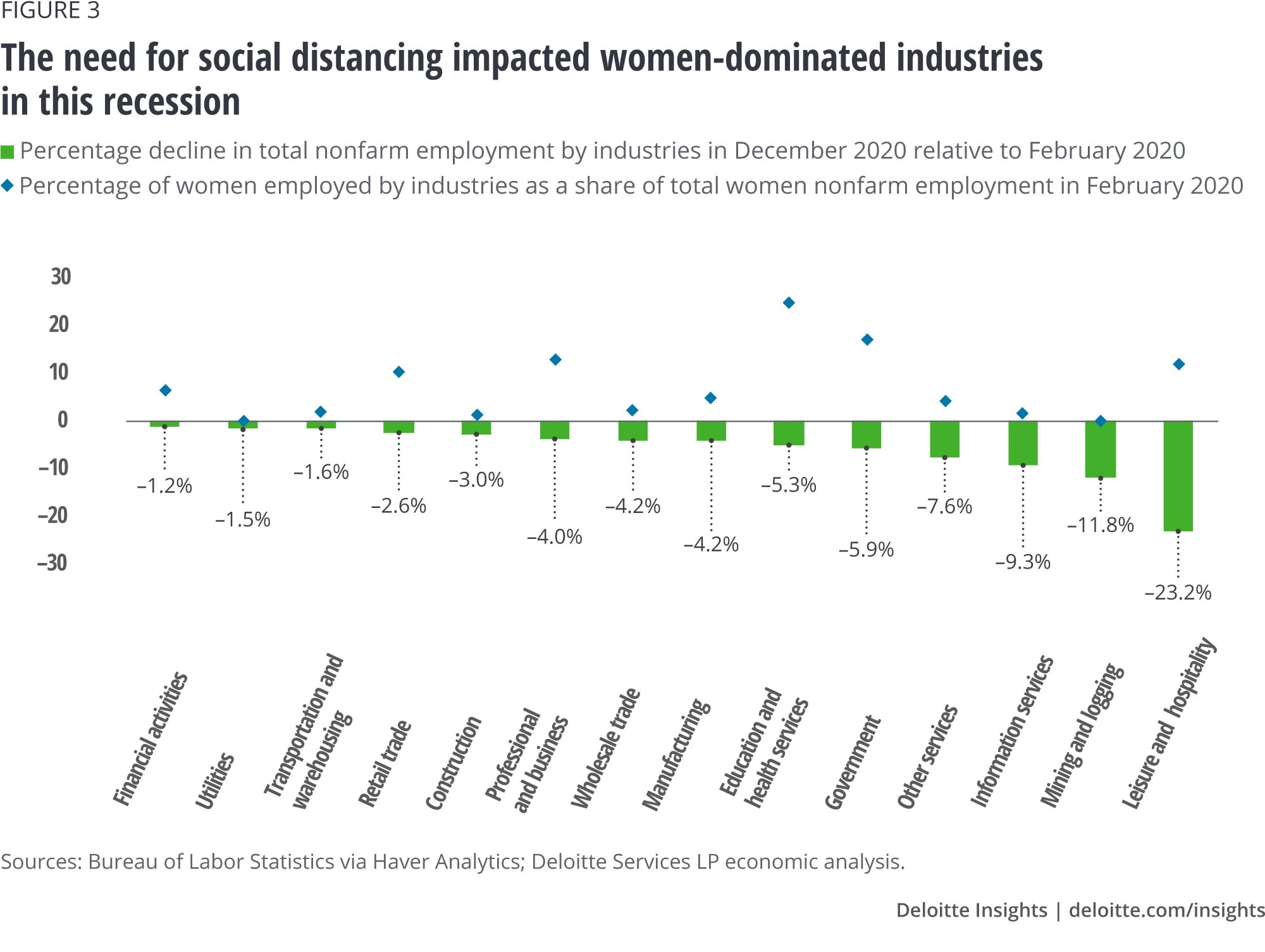
Why the COVID-19 recession has disproportionately affected women Economics Spotlight, January 2021
7 minute read
30 January 2021
More women than men have lost jobs and dropped out of the labor force due to the pandemic’s lopsided impact on the women-dominated services sector. A slow recovery, despite widespread vaccination, can have long-term economic implications for women and the economy.
It’s not uncommon for people to lose jobs during a recession. However, the labor-market impact of the COVID-19 recession has been unprecedented—millions lost jobs and dropped out of the labor force in a very short period, a drop that was not seen in any postwar recession (figure 1).

Learn more
Learn more about connecting for a resilient world
Explore the Economics collection
Learn about Deloitte’s services
Go straight to smart. Get the Deloitte Insights app
Further analysis reveals that women made up the majority of the 8 million workers that dropped out of the labor force between February and April due to the COVID-19 recession.1 During the same period, the rise in women’s unemployment rate exceeded the rise in the unemployment rate among men (figure 2). In most postwar recessions, the goods-producing sectors of the economy, which predominantly employ men, experienced relatively deeper job losses. During the COVID-19 recession, the services sector suffered more. For the first time, women, who hold more than half the jobs in the services sector, accounted for a slightly larger share of the drop in total payroll employment.2

In this article, we analyze why more women lost their jobs compared to men and how added responsibilities linked to at-home virtual schooling and inadequate childcare have made it difficult for some women to work prepandemic hours or even stay in the labor force. Finally, we highlight the risks that might arise because of potential long-term scarring of the labor market for women.
The distribution of women in the workforce placed them in the eye of the storm
Between February and April, women accounted for 12.1 million out of 22.1 million jobs lost in the United States.3 Prior to this impact, from December 2019 to February 2020, women narrowly outnumbered men in terms of total payroll employment.4
The distribution of women’s employment is of great significance when studying the impact of the current recession (figure 3). But first, some context. Private payroll employment accounts for 85% of all employment in the United States. Government, mostly state and local government, accounts for the remaining 15% of jobs. Within private payrolls, the goods-producing and service-providing sectors account for 16% and 84% of employment, respectively. Since mid-2015, women have been accounting for a growing share of payroll employment in the private goods-producing sectors of the economy, but in February 2020, this share was low at just 22.5%.5 Women’s share of payroll employment in private services is greater than that of men—it has held steady at roughly 53.5%.6 Because the pandemic necessitated social distancing and mobility restriction, service-providing sectors—and women—were hit harder. Businesses were required to stay shut and wary consumers stayed away. Moreover, within services, sectors such as education and health, and leisure and hospitality, which are skewed toward women employees, are also ranked among the riskiest due to the high probability of face-to-face discussions.7
Women also account for most government payrolls—57.8% in February 2020.8 Elevated unemployment and lower consumer spending led to fears of large budget shortfalls for state and local governments, which make up 87.5% of total government employment. Job cuts followed.

As expected, the rebound in payroll employment since April has not been as vertical as the drop. From April to December, 12.3 million jobs were restored. Women have accounted for a little more than half of all restored jobs during this period, but this is barely reason for cheer. An initial spurt in employment in May and June petered out. Fewer jobs were added in each month until November. In December, nonfarm payroll employment declined. The recovery in payroll employment in key service-providing sectors that predominantly employ women reversed direction in December due to a surge in infections and cold weather. In the private sector, leisure and hospitality and education and health services recorded job losses, while in the government sector, state and local governments registered job cuts. Together, education and health services, leisure and hospitality, and government account for slightly more than half of the jobs held by women. It is, therefore, unsurprising that women’s unemployment increased in December, with women below 24 years and above 55 years being hit harder than the rest. A slow rollout of the vaccines could hinder quick reemployment in the very sectors where women are the majority.
Online schooling and inadequate childcare have put women in a double bind
Apart from being concentrated in the most affected industries, women have also been hit by another characteristic of the recession—at-home virtual schooling and inadequate access to childcare. As of early December 2020, schools in just four states in the United States were open for full in-person instructions.9 In most states, there was no order in effect regarding school reopening—schools were either continuing with online instruction or adopting a hybrid approach.10
The surge in infections in the fall and winter months could lead schools to persist with either online education or a hybrid approach for the remainder of the school year. The rise in infections might also keep childcare centers closed, exacerbating an existing problem. Even before the pandemic, inadequate childcare supply was estimated to be equivalent to a 5% wage cut due to reduced work hours.11
Balancing remote work with household chores and childcare has impacted employment and workforce participation among women. Women with school-age children worked 11–33% fewer hours during the pandemic and lost employment ranging from 3.7 to 4.8 percentage points.12 Both measures of impact are greater than that of men with school-age children. A continuation of widescale virtual schooling and a permanent reduction in prepandemic childcare supply could widen and deepen the impact on working mothers. In 2019, there were 24.4 million employed mothers with school-age children, out of whom, almost 8 million mothers were essentially single parents.13 Single, low-income mothers, who are more likely to be women of color, are at particularly high risk of being affected.14
The economic implications of an unequal recovery could be far reaching
Perhaps more alarming than the millions of women who remain out of work is the number of them that dropped out of the labor force altogether—4.2 million between February and April. Previous exoduses from the labor force pale in comparison—the aftermath of the 2007–2009 financial crisis, for instance, resulted in the women’s labor force shrinking by less than a million over a period of more than two years. Nevertheless, in the recent labor market recovery since April, nearly 2 million women have returned to the workforce. Widespread vaccine deployment, warmer weather (allowing for outdoor dining), and an increased likelihood of enhanced fiscal stimulus could result in a fast return to the starting line in terms of employment and participation among women, especially as consumers spend on services. However, this remains far from certain. If the economic bounce back is slower, many women, especially mothers with school-age children, might find themselves out of work and even shut out of the labor force for a longer period. The economic implications of this scenario could be far reaching:
- Slower recovery: If the demand for services does not pick up as quickly as expected, even with widespread vaccine deployment, persistent underemployment of women might slow the overall economic recovery further. According to research, a slowdown in the rate of growth in women’s labor force participation since the 1990s contributed to jobless recoveries post the 1990–1991, 2001, and 2007–2009 recessions. Furthermore, weak growth in women’s labor participation could also limit growth in total factor productivity,15 therefore affecting the long-term potential output.
- Stalled progress toward gender equality: The female-to-male earnings ratio has been increasing since the early 1980s. According to the Census Bureau, the 2019 female-to-male earnings ratio was 0.823, that is, women earned 82 cents for every dollar earned by men.16 The current downturn could potentially stall wage growth for women and raise the gender pay gap. The larger supply of women relative to men in the workforce might result in slower growth in women’s wages relative to men’s wages. According to research, in this pandemic recession, the wage gap is likely to widen by five percentage points.17
- Increased retirement insecurity among women: Beyond lost wages, women lose retirement savings and benefits if they are unemployed or opt out of the labor force even for a short period of time.18 Furthermore, the risk of skill atrophy (or employer perceived skill atrophy) increases and the likelihood of reemployment at the same wage decreases the longer women spend time outside the workforce.19 This is pertinent for women especially since longer life expectancy also implies potentially higher spending. If the labor-market impact on women is sticky, then losses can compound over time. This could also raise the risk of falling into old-age poverty.
Even a quick economic recovery might not result in women making up for the disproportionate impact of the pandemic in the short term. In fact, a long hard slog is likely if women are to recover the labor-market gains made in the years prior to the pandemic.
More from the Economics collection
-
A view from London Article2 days ago
-
Federal Reserve monetary policy in the time of COVID-19 Article3 years ago
-
State of the US consumer: June 2024 Article2 weeks ago









